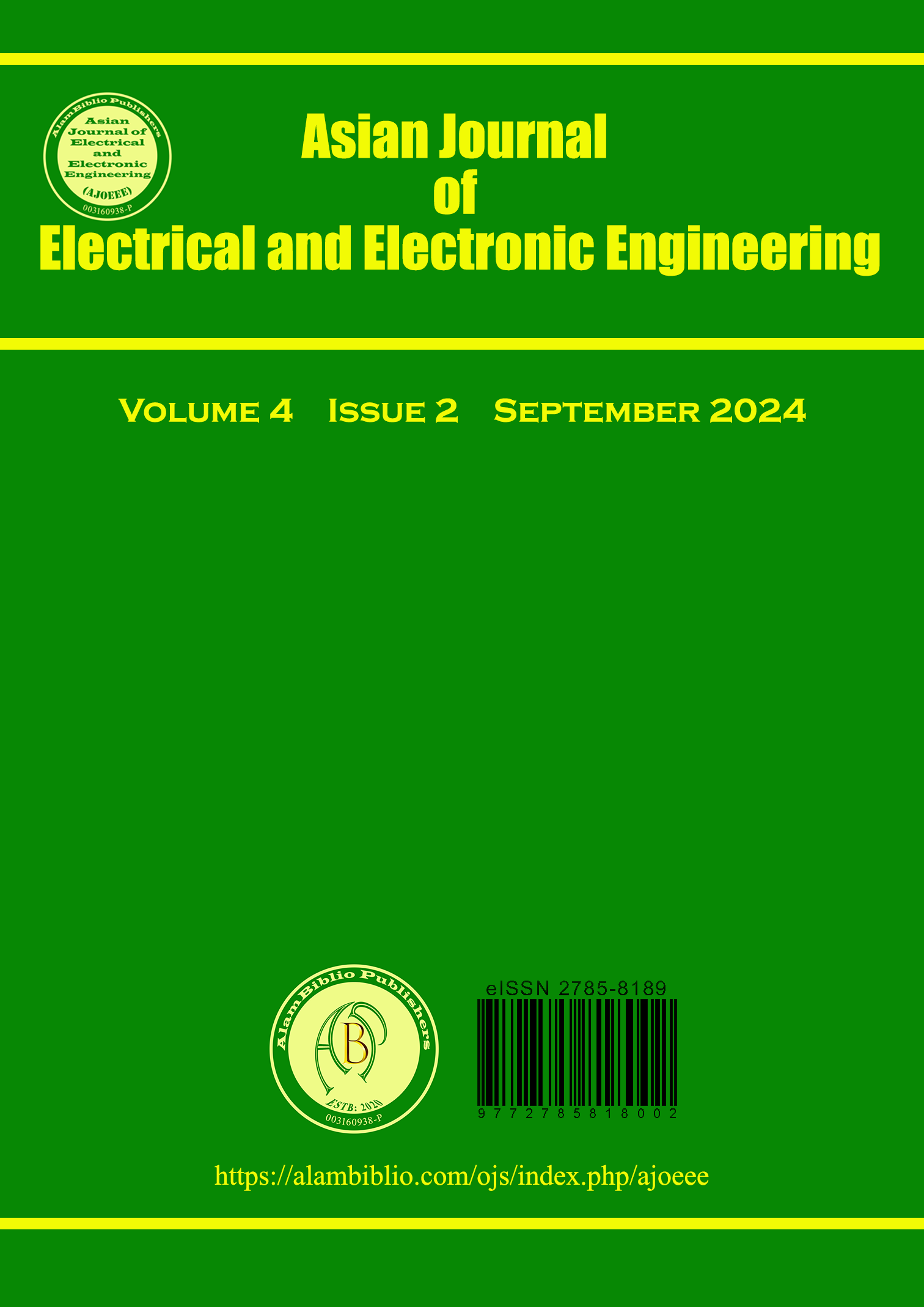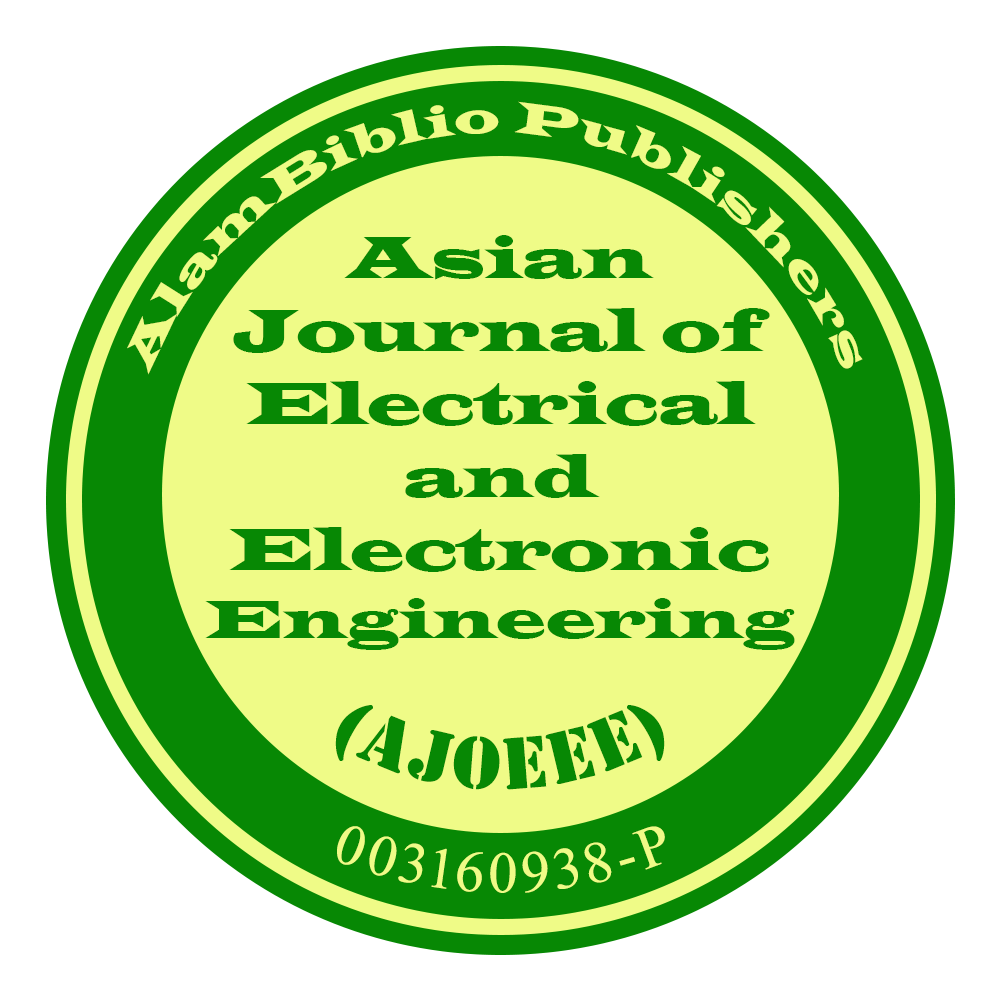Improving the Privacy in Wireless-Enabled 5G Networks: A Lightweight Protocol for IIoT Communications
DOI:
https://doi.org/10.69955/ajoeee.24.v4i2.62Keywords:
Wireless, Privacy, VID, AI/ML, IIoT, Security threats, 5G networksAbstract
The vision and major elements of the fifth generation (5G) ecosystem have previously been explored. We examine how security may impact the envisioned 5G wireless systems and the challenges and potential solutions to aid in these efforts and define the security and privacy aspects of 5G networks. 5G networks have provided solutions for quicker machine control, problem identification, performance analysis, and data access. Interaction between Internet of Things (IoT) nodes occur across an unsecured wireless channel, which has positive and negative effects. Despite being physically separated, unauthorized nodes could communicate via an unprotected wireless channel to gather data and take over industrial devices. Secure sessions can mitigate these risks, but it might be challenging to construct a secure session over a weak channel. To address this issue, the Variable Identification (VID) is used. VID offers a simple key exchange platform to authorized Industry Internet of Things (IIoT) nodes while guarding against unauthorized use. The lightweight changeable pseudonyms used by VID for trust-building are selected at random from a pool discovered in the home network and terminal devices. All IDs are chosen at random from a pool and are used to protect data against forgery, replay, alteration, impersonation, and man-in-the-middle attacks, among other things, between the home network and terminal equipment. The ProVerif tool is used to evaluate the suggested system, and the findings demonstrate that it is trustworthy and resistant to prospective attacks.
Metrics
Downloads
References
[1]. Peter, O., Pradhan, A., & Mbohwa, C. Industrial internet of things (IIoT): opportunities, challenges, and requirements in manufacturing businesses in emerging economies. Procedia Computer Science, (2023), 217, 856-865, https://doi.org/10.1016/j.procs.2022.12.282 DOI: https://doi.org/10.1016/j.procs.2022.12.282
[2]. Kumar, R., Rani, S., & Awadh, M. A. Exploring the application sphere of the internet of things in industry 4.0: a review, bibliometric and content analysis. Sensors, (2022), 22(11), 4276, https://doi.org/10.3390/s22114276. DOI: https://doi.org/10.3390/s22114276
[3]. Garrido, G. M., Sedlmeir, J., Uludağ, Ö., Alaoui, I. S., Luckow, A., & Matthes, F. Revealing the landscape of privacy-enhancing technologies in the context of data markets for the IoT: A systematic literature review. Journal of Network and Computer Applications, (2022), 207, 103465, https://doi.org/10.1016/j.jnca.2022.103465 DOI: https://doi.org/10.1016/j.jnca.2022.103465
[4]. Ali, A., Al-Rimy, B. A. S., Alsubaei, F. S., Almazroi, A. A., & Almazroi, A. A. HealthLock: Blockchain-Based Privacy Preservation Using Homomorphic Encryption in Internet of Things Healthcare Applications. Sensors, (2023), 23(15), 6762, https://doi.org/10.3390/s23156762 DOI: https://doi.org/10.3390/s23156762
[5]. Rizi, M. H. P., & Seno, S. A. H. A systematic review of technologies and solutions to improve security and privacy protection of citizens in the smart city. Internet of Things, (2022), 20, 100584, https://doi.org/10.1016/j.iot.2022.100584 DOI: https://doi.org/10.1016/j.iot.2022.100584
[6]. Kamdjou, H. M., Baudry, D., Havard, V., & Ouchani, S. Resource-Constrained eXtended Reality Operated With Digital Twin in Industrial Internet of Things. IEEE Open Journal of the Communications Society, (2024), https://doi.org/10.1109/OJCOMS.2024.3356508 DOI: https://doi.org/10.1109/OJCOMS.2024.3356508
[7]. Kamarudin, N. H., Suhaimi, N. H. S., Nor Rashid, F. A., Khalid, M. N. A., & Mohd Ali, F. Exploring Authentication Paradigms in the Internet of Things: A Comprehensive Scoping Review. Symmetry, (2024), 16(2), 171, https://doi.org/10.3390/sym16020171 DOI: https://doi.org/10.3390/sym16020171
[8]. Mengistu, T. M., Kim, T., & Lin, J. W. A Survey on Heterogeneity Taxonomy, Security and Privacy Preservation in the Integration of IoT, Wireless Sensor Networks and Federated Learning. Sensors, (2024), 24(3), 968, https://doi.org/10.3390/s24030968 DOI: https://doi.org/10.3390/s24030968
[9.] Alotaibi, B. A survey on industrial Internet of Things security: Requirements, attacks, AI-based solutions, and edge computing opportunities. Sensors, (2023), 23(17), 7470, https://doi.org/10.3390/s23177470 DOI: https://doi.org/10.3390/s23177470
[10]. Mohsan, S. A. H., & Li, Y. A Contemporary Survey on 6G Wireless Networks: Potentials, Recent Advances, Technical Challenges and Future Trends. arXiv preprint arXiv:2306.08265, (2023), https://doi.org/10.48550/arXiv.2306.08265
[11]. Yazici, İ., Shayea, I., & Din, J. A survey of applications of artificial intelligence and machine learning in future mobile networks-enabled systems. Engineering Science and Technology, an International Journal, (2023), 44, 101455, https://doi.org/10.1016/j.jestch.2023.101455 DOI: https://doi.org/10.1016/j.jestch.2023.101455
[12]. Huda Mahmood, Nurul, et al. "Six Key Enablers for Machine Type Communication in 6G." arXiv e-prints (2019): arXiv-1903, https://doi.org/10.48550/arXiv.1903.05406
[13]. Hasan, M. K., et al. "Inter-cell interference coordination in LTE-A HetNets: A survey on self organizing approaches." 2013 International Conference on Computing, Electrical and Electronic Engineering (ICCEEE). IEEE, 2013, https://doi.org/10.1109/ICCEEE.2013.6633932 DOI: https://doi.org/10.1109/ICCEEE.2013.6633932
[14]. Saeed, M. M. A., Saeed, R. A., & Ahmed, Z. E. (2024). Data Security and Privacy in the Age of AI and Digital Twins. In Digital Twin Technology and AI Implementations in Future-Focused Businesses (pp. 99-124). IGI Global, https://doi.org/10.4018/979-8-3693-1818-8.ch008 DOI: https://doi.org/10.4018/979-8-3693-1818-8.ch008
[15]. Saeed, Mamoon M., et al. "A novel variable pseudonym scheme for preserving privacy user location in 5G networks." Security and Communication Networks 2022 (2022), https://doi.org/10.1155/2022/7487600 DOI: https://doi.org/10.1155/2022/7487600
[16]. Hasan, Mohammad Kamrul, et al. "Evolution of industry and blockchain era: monitoring price hike and corruption using BIoT for smart government and industry 4.0." IEEE Transactions on Industrial Informatics 18.12 (2022): 9153-9161, https://doi.org/10.1109/TII.2022.3164066 DOI: https://doi.org/10.1109/TII.2022.3164066
[17]. Strinati, Emilio Calvanese, et al. "6G: The next frontier: From holographic messaging to artificial intelligence using subterahertz and visible light communication." IEEE Vehicular Technology Magazine 14.3 (2019): 42-50, https://doi.org/10.1109/MVT.2019.2921162 DOI: https://doi.org/10.1109/MVT.2019.2921162
[18]. Tariq, Faisal, et al. "A speculative study on 6G." IEEE Wireless Communications 27.4 (2020): 118-125, DOI: 10.1109/MWC.001.1900488 DOI: https://doi.org/10.1109/MWC.001.1900488
[19]. Van Der Zwaag, Klaas Minne, et al. "A manchester-ook visible light communication system for patient monitoring in intensive care units." IEEE Access 9 (2021): 104217-104226, https://doi.org/10.1109/ACCESS.2021.3099462 DOI: https://doi.org/10.1109/ACCESS.2021.3099462
[20]. Saeed, Mamoon M., et al. "A comprehensive review on the users’ identity privacy for 5G networks." IET Communications 16.5 (2022): 384-399, https://doi.org/10.1049/cmu2.12327 DOI: https://doi.org/10.1049/cmu2.12327
[21]. Saeed, Mamoon M., et al. "Task Reverse Offloading with Deep Reinforcement Learning in Multi-Access Edge Computing." 2023 9th International Conference on Computer and Communication Engineering (ICCCE). IEEE, 2023, https://doi.org/10.1109/ICCCE58854.2023.10246081 DOI: https://doi.org/10.1109/ICCCE58854.2023.10246081
[22]. Ahmed, Zeinab E., et al. "Mobility Management Enhancement in Smart Cities using Software Defined Networks." Scientific African (2023): e01932, https://doi.org/10.1016/j.sciaf.2023.e01932 DOI: https://doi.org/10.1016/j.sciaf.2023.e01932
[23]. Amanlou, Sanaz, Mohammad Kamrul Hasan, and Khairul Azmi Abu Bakar. "Lightweight and secure authentication scheme for IoT network based on publish–subscribe fog computing model." Computer Networks 199 (2021): 108465, https://doi.org/10.1016/j.comnet.2021.108465 DOI: https://doi.org/10.1016/j.comnet.2021.108465
[24] Huda Mahmood, Nurul, et al. "Six Key Enablers for Machine Type Communication in 6G." arXiv e-prints (2019): arXiv-1903, https://doi.org/10.48550/arXiv.1903.05406
[25]. Saeed, Mamoon M., et al. "Attacks Detection in 6G Wireless Networks using Machine Learning." 2023 9th International Conference on Computer and Communication Engineering (ICCCE). IEEE, 2023, https://doi.org/10.1109/ICCCE58854.2023.10246078 DOI: https://doi.org/10.1109/ICCCE58854.2023.10246078
[26]. Saeed, Mamoon M., et al. "Green Machine Learning Approach for QoS Improvement in Cellular Communications." 2022 IEEE 2nd International Maghreb Meeting of the Conference on Sciences and Techniques of Automatic Control and Computer Engineering (MI-STA). IEEE, 2022, https://doi.org/10.1109/MI-STA54861.2022.9837585 DOI: https://doi.org/10.1109/MI-STA54861.2022.9837585
[27]. Saeed, Mamoon M., et al. "Anomaly Detection in 6G Networks Using Machine Learning Methods." Electronics 12.15 (2023): 3300, https://doi.org/10.3390/electronics12153300 DOI: https://doi.org/10.3390/electronics12153300
[28]. Muthana, Abdulrahman A., and Mamoon M. Saeed. "Analysis of user identity privacy in LTE and proposed solution." International Journal of Computer Network and Information Security 9.1 (2017): 54, https://doi.org/.5815/ijcnis.2017.01.07 DOI: https://doi.org/10.5815/ijcnis.2017.01.07
[29]. Saeed, Mamoon M., Rashid A. Saeed, and Elsadig Saeid. "Preserving privacy of paging procedure in 5th G using identity-division multiplexing." 2019 First International Conference of Intelligent Computing and Engineering (ICOICE). IEEE, 2019, https://doi.org/10.1109/ICOICE48418.2019.9035167 DOI: https://doi.org/10.1109/ICOICE48418.2019.9035167
[30]. Saeed, Mamoon M., et al. "Preserving Privacy of User Identity Based on Pseudonym Variable in 5G." Computers, Materials & Continua 70.3 (2022), https://doi.org/10.32604/cmc.2022.017338 DOI: https://doi.org/10.32604/cmc.2022.017338
[31]. Wang, Qixu, et al. "PCP: A privacy-preserving content-based publish–subscribe scheme with differential privacy in fog computing." IEEE Access 5 (2017): 17962-17974, https://doi.org/10.1109/ACCESS.2017.2748956 DOI: https://doi.org/10.1109/ACCESS.2017.2748956
[32]. Bonawitz, Keith, et al. "Towards federated learning at scale: System design." Proceedings of machine learning and systems 1 (2019): 374-388, https://doi.org/10.48550/arXiv.1902.01046
[33]. Niknam, Solmaz, Harpreet S. Dhillon, and Jeffrey H. Reed. "Federated learning for wireless communications: Motivation, opportunities, and challenges." IEEE Communications Magazine 58.6 (2020): 46-51, https://doi.org/10.1109/MCOM.001.1900461 DOI: https://doi.org/10.1109/MCOM.001.1900461
[34]. Ylianttila, Mika, et al. "6G white paper: Research challenges for trust, security and privacy." arXiv preprint arXiv:2004.11665 (2020), https://doi.org/10.48550/arXiv.2004.116
[35]. Das, Ashok Kumar, et al. "Biometrics-based privacy-preserving user authentication scheme for cloud-based industrial Internet of Things deployment." IEEE Internet of Things Journal 5.6 (2018): 4900-4913, https://doi.org/10.1109/JIOT.2018.2877690 DOI: https://doi.org/10.1109/JIOT.2018.2877690
[36]. Saeed, R. A., Saeed, M. M., Ahmed, Z. E., & Hashim, A. H. (2024). Enhancing Medical Services Through Machine Learning and UAV Technology: Applications and Benefits. In Applications of Machine Learning in UAV Networks (pp. 307-343). IGI Global https://doi.org/10.4018/979-8-3693-0578-2.ch012 DOI: https://doi.org/10.4018/979-8-3693-0578-2.ch012
[37]. Li, Xiong, et al. "A robust and energy efficient authentication protocol for industrial internet of things." IEEE Internet of Things Journal 5.3 (2017): 1606-1615, https://doi.org/10.1109/JIOT.2017.2787800 DOI: https://doi.org/10.1109/JIOT.2017.2787800
[38]. Esfahani, Alireza, et al. "A lightweight authentication mechanism for M2M communications in industrial IoT environment." IEEE Internet of Things Journal 6.1 (2017): 288-296, https://doi.org/10.1109/JIOT.2017.2737630 DOI: https://doi.org/10.1109/JIOT.2017.2737630
[39]. Xiong Li, et al. "A robust ECC-based provable secure authentication protocol with privacy preserving for industrial Internet of Things." IEEE Transactions on Industrial Informatics 14.8 (2017): 3599-3609, https://doi.org/10.1109/TII.2017.2773666 DOI: https://doi.org/10.1109/TII.2017.2773666
[40]. Paliwal, Swapnil. "Hash-based conditional privacy preserving authentication and key exchange protocol suitable for industrial internet of things." IEEE Access 7 (2019): 136073-136093, https://doi.org/10.1109/ACCESS.2019.2941701 DOI: https://doi.org/10.1109/ACCESS.2019.2941701
[41]. Chang, Chin-Chen, and Hai-Duong Le. "A provably secure, efficient, and flexible authentication scheme for ad hoc wireless sensor networks." IEEE Transactions on wireless communications 15.1 (2015): 357-366, https://doi.org/10.1109/TWC.2015.2473165 DOI: https://doi.org/10.1109/TWC.2015.2473165
[42]. Gope, Prosanta, et al. "Lightweight and physically secure anonymous mutual authentication protocol for real-time data access in industrial wireless sensor networks." IEEE transactions on industrial informatics 15.9 (2019): 4957-4968, https://doi.org/10.1109/TII.2019.2895030 DOI: https://doi.org/10.1109/TII.2019.2895030
[43]. Sun, Yuanyuan, et al. "When machine learning meets privacy in 6G: A survey." IEEE Communications Surveys & Tutorials 22.4 (2020): 2694-2724, https://doi.org/10.1109/COMST.2020.3011561 DOI: https://doi.org/10.1109/COMST.2020.3011561
[44]. Shakiba-Herfeh, Mahdi, Arsenia Chorti, and H. Vincent Poor. "Physical layer security: Authentication, integrity, and confidentiality." Physical layer security (2021): 129-150, https://doi.org/10.1007/978-3-030-55366-1_6 DOI: https://doi.org/10.1007/978-3-030-55366-1_6
[45]. Ahmed, Mohammed Imtyaz, and Govindaraj Kannan. "Secure and lightweight privacy preserving Internet of things integration for remote patient monitoring." Journal of King Saud University-Computer and Information Sciences 34.9 (2022): 6895-6908, https://doi.org/10.1016/j.jksuci.2021.07.016 DOI: https://doi.org/10.1016/j.jksuci.2021.07.016
[46]. Chiu, Wei-Yang, Weizhi Meng, and Chunpeng Ge. "NoSneaky: A Blockchain-Based Execution Integrity Protection Scheme in Industry 4.0." IEEE Transactions on Industrial Informatics (2022), https://doi.org/10.1109/TII.2022.3215606 DOI: https://doi.org/10.1109/TII.2022.3215606
[47]. Luo, Xi, et al. "A lightweight privacy-preserving communication protocol for heterogeneous IoT environment." IEEE Access 8 (2020): 67192-67204, https://doi.org/10.1109/ACCESS.2020.2978525 DOI: https://doi.org/10.1109/ACCESS.2020.2978525
[48]. Almaiah, Mohammed Amin, et al. "A lightweight hybrid deep learning privacy preserving model for FC-based industrial internet of medical things." Sensors 22.6 (2022): 2112, https://doi.org/10.3390/s22062112 DOI: https://doi.org/10.3390/s22062112
[49]. Osorio, Diana Pamela Moya, et al. "Towards 6G-enabled internet of vehicles: Security and privacy." IEEE Open Journal of the Communications Society 3 (2022): 82-105, https://doi.org/10.1109/OJCOMS.2022.3143098 DOI: https://doi.org/10.1109/OJCOMS.2022.3143098
[50]. Wang, Ding, Wenting Li, and Ping Wang. "Measuring two-factor authentication schemes for real-time data access in industrial wireless sensor networks." IEEE Transactions on Industrial Informatics 14.9 (2018): 4081-4092, https://doi.org/10.1109/TII.2018.2834351 DOI: https://doi.org/10.1109/TII.2018.2834351
[51]. Sooriakumaran, Prasanna, et al. "A multinational, multi-institutional study comparing positive surgical margin rates among 22 393 open, laparoscopic, and robot-assisted radical prostatectomy patients." European urology 66.3 (2014): 450-456, https://doi.org/10.1016/j.eururo.2013.11.018 DOI: https://doi.org/10.1016/j.eururo.2013.11.018
Downloads
Published
Issue
Section
License
Copyright (c) 2024 AlamBiblilo Publishers

This work is licensed under a Creative Commons Attribution-NonCommercial 4.0 International License.
The Asian Journal of Electrical and Electronic Engineering journal is licensed under a Creative Commons Attribution-NonCommercial 4.0 International License.














